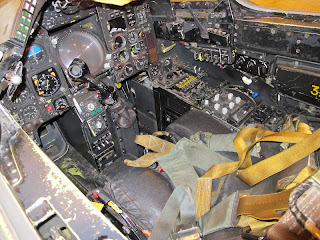The recently delivered Nimrod R1. Unlike our sub-hunting MR2 at Manchester, the job of this version of the Nimrod was electronic intelligence-gathering
Bristol 188, supposedly a Mach two aeroplane built to investigate an airframe made of advanced materials (stainless steel in this case) to overcome the problems of airframe dynamic heating at high supersonic speeds. Unfortunately it only managed Mach 1.88 and didn't have the fuel capacity to remain at high speed for long enough to gather any meaningful data.
TSR2. Cancelled by a Labour government when on the cusp of entering service, controversy still reigns as to just what we missed though its loss. Those involved insist it was years ahead of anything else in military aviation, others that with such a small wing its low speed performance (for short field landing, one of the design objectives) and its manoeuvrability in flight must have been questionable (the Starfighter had similarly tiny wings and was pretty useless except in a straight line).
The Prone Meteor. With a safety pilot in the conventional cockpit, the front cockpit housed a pilot laying on his stomach to minimise the 'blood draining to the legs' effect of sustained high 'G'. Its purpose was negated by the invention of 'G suits'; trousers which inflate under high 'G' to preclude that effect.
The Rolls Royce (originally Bristol Engines) Olympus, as used in the Vulcan bomber among other aeroplanes, developed with re-heat for the TSR2. On cancellation of the project, this Olympus development was continued by the Concorde team to produce the 40,000lb thrust Olympus 593 for that fabulous aeroplane.
One of the Avro 707 delta research aircraft which helped the firm to develop the mighty Vulcan bomber
You can't usually sit in any of the Cosford aeroplanes, but one of the guides had recently been on one of my Nimrod technical tours so opened up the Jet Provost for us to sit in!
How do you service a Catalina's engine when it's so high off the ground, or moored at sea? You use this demountable platform that allows access from the top of the wing.
The Lightning in typical pose... blasting vertically skywards on the massive thrust of its two re-heated Avons
An aeroplane (Gloster Javelin) that perhaps belies the old saw 'if it looks good it flies good'. It looks good, but it didn't live up to expectations as an aeroplane.
After lunch we joined a guided tour of RAF Cosford's hangars. Here, young RAF apprentices learn the trades of airframe, engine, and avionics maintenance. They mostly use the now-retired Jaguar fighter, and some Gazelle helicopters (like this one) and a few Jet Provosts.
A general view across one of the many hangars of Jaguar airframes now used for maintenance training
The last Jag to land at Cosford (so the last ever to fly) was 'Echo Delta' (ED), known as 'ED the Duck'. It carries a suitable piece of nose prose.
Out on the airfield several Jags are kept in taxiable condition for the training of marshallers and of 'taxi pilots' (technicians qualified to start the engines and taxy the jets on the ground to position them for maintenance). The 2-seater is used for initial taxy training before the students transfer to the single seaters.
2-seater in the foreground, single seaters behind
This Jag's nose art indicates it took part in the Gulf War
Jag office
Gazelle office
I didn't expect to find a Christen Eagle among all these warbirds! Someone's nice toy!
A Jag out on the pan.. one of the taxyable machines
A Jag showing its true colours.....
Out on the airfield some old JPs await their fate. Civvy street or the scrap man?
Here are some Jags taxying past. Click on the link.
http://www.youtube.com/watch?v=yPYQ0kZ0EeA&feature=youtu.be
http://www.youtube.com/watch?v=bVQ92fOIh-U&feature=youtu.be
.






















No comments:
Post a Comment